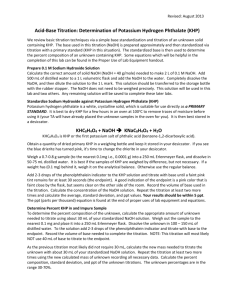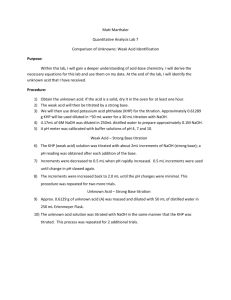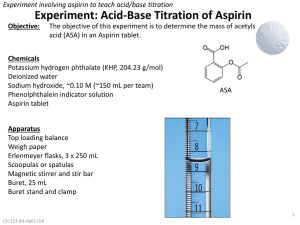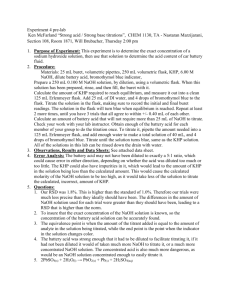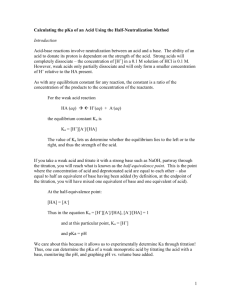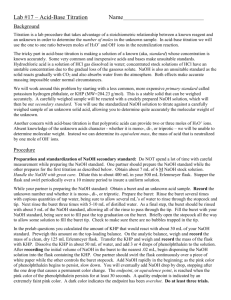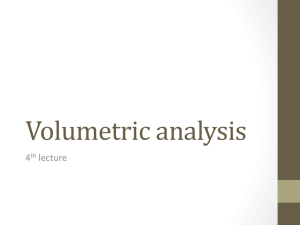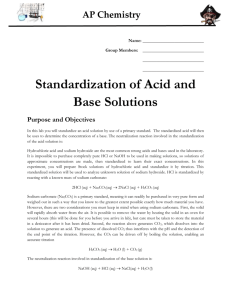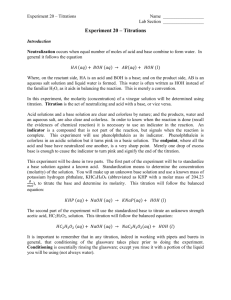Acid-Base Titrations
advertisement
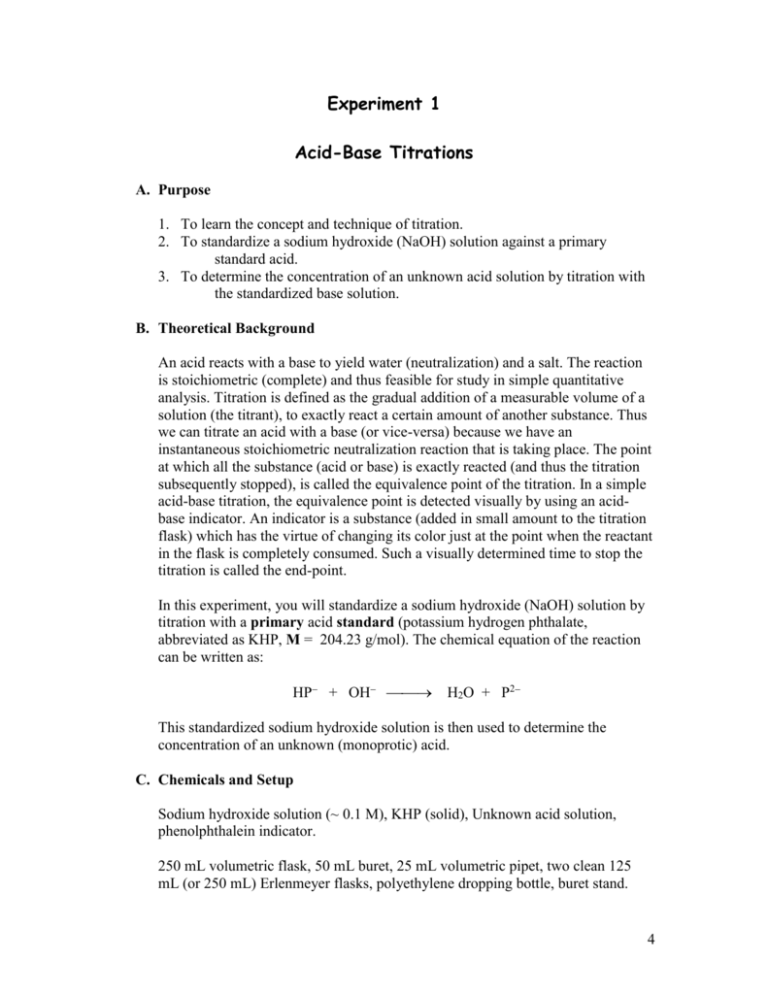
Experiment 1 Acid-Base Titrations A. Purpose 1. To learn the concept and technique of titration. 2. To standardize a sodium hydroxide (NaOH) solution against a primary standard acid. 3. To determine the concentration of an unknown acid solution by titration with the standardized base solution. B. Theoretical Background An acid reacts with a base to yield water (neutralization) and a salt. The reaction is stoichiometric (complete) and thus feasible for study in simple quantitative analysis. Titration is defined as the gradual addition of a measurable volume of a solution (the titrant), to exactly react a certain amount of another substance. Thus we can titrate an acid with a base (or vice-versa) because we have an instantaneous stoichiometric neutralization reaction that is taking place. The point at which all the substance (acid or base) is exactly reacted (and thus the titration subsequently stopped), is called the equivalence point of the titration. In a simple acid-base titration, the equivalence point is detected visually by using an acidbase indicator. An indicator is a substance (added in small amount to the titration flask) which has the virtue of changing its color just at the point when the reactant in the flask is completely consumed. Such a visually determined time to stop the titration is called the end-point. In this experiment, you will standardize a sodium hydroxide (NaOH) solution by titration with a primary acid standard (potassium hydrogen phthalate, abbreviated as KHP, M = 204.23 g/mol). The chemical equation of the reaction can be written as: HP + OH H2O + P2 This standardized sodium hydroxide solution is then used to determine the concentration of an unknown (monoprotic) acid. C. Chemicals and Setup Sodium hydroxide solution (~ 0.1 M), KHP (solid), Unknown acid solution, phenolphthalein indicator. 250 mL volumetric flask, 50 mL buret, 25 mL volumetric pipet, two clean 125 mL (or 250 mL) Erlenmeyer flasks, polyethylene dropping bottle, buret stand. 4 D. Procedure Preparation of a solution of primary standard (KHP) 1. Obtain from the stock room a sample of solid KHP. Weigh accurately (by difference) about 3 g of KHP. 2. Transfer this weight quantitatively to a 250 mL volumetric flask. Swirl thoroughly to dissolve the solid, then make up to the mark with distilled water. 3. Calculate the molarity of the KHP solution that you have just prepared. Standardization of the NaOH solution 1. Rinse your clean buret with distilled water then with the NaOH solution. Fill the buret with NaOH solution (the solution in the buret should be free of air bubbles). Record the upper buret reading. 2. Pipet 25.00 mL of the KHP solution into a clean Erlenmeyer flask. Add 25 mL of distilled water (with a graduated cylinder here, there is no need for accurate measurement, why?). Then add 2 drops of phenolphthalein indicator. 3. Titrate the resulting solution with the NaOH solution carefully until the indicator changes color (from colorless [acidic] to faint pink [basic]). 4. Record the lower buret reading. 5. Repeat steps (2) through (4) until the titration volumes in at least two runs agree within 0.10 mL. 6. Carry out a blank titration. (The blank solution contains 50 mL of distilled water and 2 drops of indicator). Determination of the concentration of an unknown acid 1. Pipet 25.00 mL of the unknown acid solution provided by your lab instructor into a clean Erlenmeyer flask. Add 25 mL of distilled water and 2 drops of phenolphthalein indicator. 2. Titrate the solution with the NaOH solution carefully until the indicator changes color. 3. Record the lower buret reading. 4. Repeat steps (2) through (4) until the titration volumes in at least two runs agree within 0.10 mL. 5. Carry out a blank titration. 5 E. CHEM. 203 Lab Report NAME : _______________________ EXPERIMENT No. : ______________ TITLE : __________________________________ DATE : ________________ Partner : ________________________ Preparation of a solution of primary standard (KHP) M 0KHP m KHP M KHP Vsoln = Standardization of the NaOH solution 1 2 3 Blank Upper reading (mL) Lower reading (mL) Volume (mL) Average volume, v NaOH v v blank M 0NaOH M 0KHP v KHP v NaOH = Determination of the concentration of an unknown acid 1 2 3 Blank Upper reading (mL) Lower reading (mL) Volume (mL) 6 Average volume, v NaOH v v blank M 0unk M 0NaOH v NaOH v unk = Questions 1. A sodium carbonate (Na2CO3) primary standard solution is prepared by dissolving 10.587 g of the substance in enough distilled water, then transferring it quantitatively to a 250 mL volumetric flask and finally making up to the mark with distilled water. The volumetric flask is labeled T.C. 0.12 mL. Calculate the molarity of the standard Na2CO3 solution. 2. 10.00 mL of a dilute acetic acid solution are titrated with a sodium hydroxide (NaOH) solution of molar concentration 0.1078 M. At the equivalence point, it is found that 13.42 mL of NaOH have been added. What is the molarity of the unknown acetic acid solution? 7 3. Write out a balanced reaction for the neutralization of sulfuric acid (H2SO4) with sodium hydroxide. What volume of 0.541 M NaOH is necessary to react completely 20.0 mL of sulfuric acid whose molarity is 1.26 M? 4. Explain why we run a blank titration. 5. The equivalence point of the titration of a weak base with a strong acid occurs at pH 5.32. Which of the following indicators is the best to detect the end-point of the titration? Indicator Bromophenol blue Methyl orange Methyl red Bromocresol green Color change yellow – blue red – yellow pink – yellow Yellow – blue pH range 3.1 – 4.6 3.3 – 4.5 4.2 – 6.3 3.8 – 5.4 Sketch the titration curve for this titration. 8

